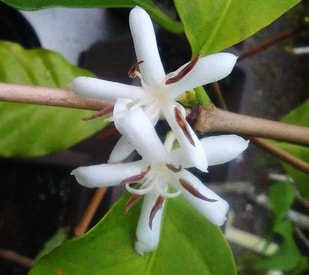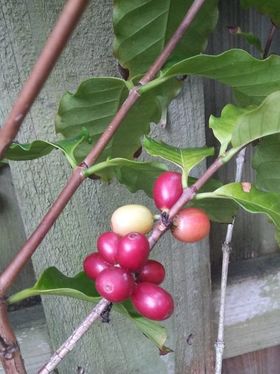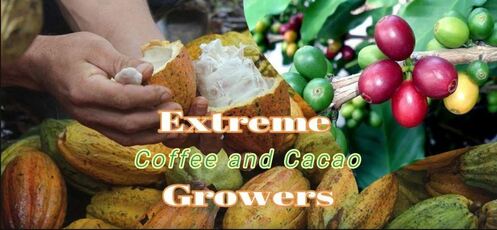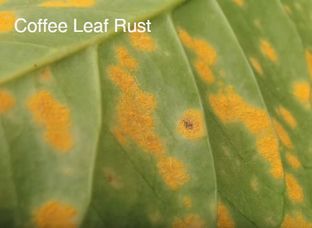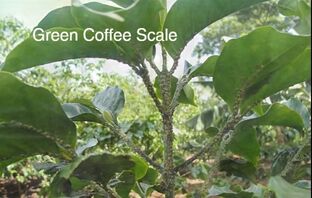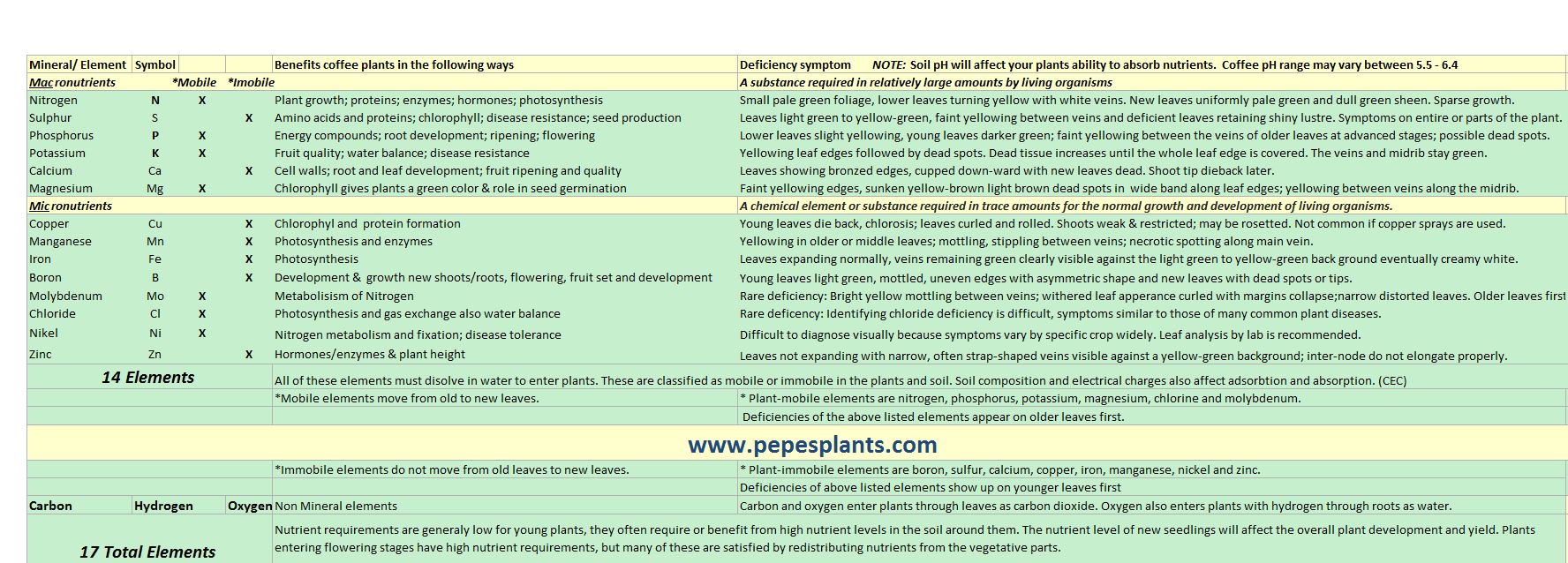It’s fun to grow most any plant, but it can be even more rewarding when a plant gives you coffee. Yes, and you can also feed some to your goats!
Origins of coffee
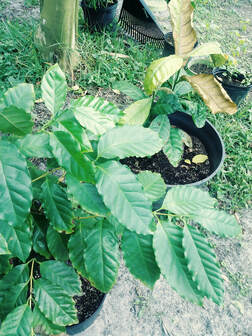
Legend has it that the origin of coffee is traced to an Ethiopian goat herder named Kaldi. One fine sunny morning, Kaldi noticed his goats frolicking and running around, jumping like never before. He wondered what the heck, this is odd for these particular goats. "These are my lazy old goats!" When Kaldi investigated, he saw that the goats were happily eating the red berries and shiny leaves of a plant he had not seen before. So he decided to eat some cherries and within a short while he too felt energized and very alert. It was a great little energy "buzz" so to speak. Later that afternoon a monk, walking along a path, observed Kaldi and the goats. When he told the monk about the effects the cherries had on the goats and himself, the monk wondered if the cherries could be the answer to his prayers. You see, this monk was always falling asleep in the middle of prayers. The monk came up with the idea of drying and boiling the berries to make a beverage. He found the beverage delicious and he stayed awake! Pretty soon the monk opened his own Coffee Shop and became very, very wealthy! LOL. :-) Come on Pepe! you expect me to believe that story? Well okay who knows it's just a legend after all. Now read the rest below its for real and will help you grow great coffee plants. Before coffee was a beverage it was actually used as food by the native people of Ethiopia and Yemen. Ethiopia is considered the Motherland of coffee. Coffee was cultivated all over the African continent and it found its way to the Middle East, South and Central America. The plant is also grown in the Caribbean, Indonesia and in about 50 other countries with tropical and subtropical climates. Today, to the surprise of many people, we have coffee plantations in California around Santa Barbara County. With help from the University of California Cooperative Extension and UC Davis, the movement is gaining steam and now farmers in San Diego are looking seriously at taking a crack at growing coffee. Often times the impossible is possible thanks to the dedication and perseverance of agricultural explorers, scientists, farmers and visionaries. Keep in mind that dates came from Morocco to California in the early 1900's. Have you ever enjoyed a California grown date? I bet you have and they are awesome so why not coffee? Coffee growing in Florida or other areas outside the coffee belt Florida on the other hand and even Texas may offer the opportunity to grow coffee plants on a commercial bases. The popular belief among experts however is that neither of these regions provide the altitude, soil or climate that coffee needs to flourish and produce a fine cup of java. Contrary to that belief stand several hobby growers (including me) that grow coffee plants successfully in Florida. Some swear they produce a great tasting backyard brew. As for me, for now, I will focus on growing the plants and propagating them. The work of coffee bean processing, I will leave to those that are so inclined. Growing coffee indoors: Light, humidity, containers, soil, watering, fertilizer, pests, hand pollination........ This section coming soon Coffee growing fundamentals: Coffee trees can live to be 70 - 100 years of age. They can be very large trees in the wild but cultivation methods strive to maintain trees around six to eight feet tall. Dwarf varieties like Catura and Catui are ideal choices for growing in containers. Actually, most all coffee trees can be container grown and make great houseplants too. Growing coffee plants in containers often provides a better soil environment. For example... Florida soils tend to be alkaline and coffee grows best in acidic soil, the container and the medium selected allows for better pH adjustments. The ideal pH for your plants is right around 6.4. One other good reason for choosing containers is the cool weather we get a few times a year. Coffee trees prefer an ideal temperatures between 59 F - 75 F (15-24 C), with high humidity, and protection from windy conditions. Growing in a container makes it easier to bring them in from any temperature extremes. Most coffee is started from seed but if you have a plant you can propagate them from stem cuttings. Using a stem cutting from a mature plant will produce coffee very quickly. No need to wait 2 - 3 years for a seedling plant to reach maturity. Your cutting is a clone of the already mature fruit bearing mother plant. Now let’s look at the two types of coffee you can grow. We will focus on growing Arabica Coffee ( Coffea arabica). The other type is called (Coffea canephora) aka: Robusta. Arabica: is grown in the tropics and sub-tropics at elevations starting around 3,200 feet or more above sea level. Arabica is the preferred commercial variety and almost 75% of all coffee grown and sold worldwide is of this type. Arabica is a much milder and better tasting (sweeter less acidic) coffee with less caffeine than Robusta. Arabica plants have perfect flowers with both male and female parts on the same plant and it is self pollinating. Arabica generally produces cherries after 3 - 4 years if grown from a seed. A coffee plant is at peak production when about six - eight years of age. A five foot plant can yield about two, maybe three pounds of dried coffee beans per year. Robusta: is a lower quality coffee and prices are normally about 30 to 40% less than Arabica. Robusta is used for instant coffee and espresso. This species of coffee grows in hotter climates than arabica and at lower altitudes and requires cross pollination. The plant is also more cold tolerant than arabica. Robusta is more vigorous, more productive and less vulnerable to rust. Robusta may be a good choice for growing in Florida because it may provide protection from nasty soil nematodes that can attack coffee roots. The image on the right demonstrates that arabica is much more cold hardy than robusta. To the far right in the image is a robusta plant exposed to 45 degrees Fahrenheit for just one evening here in South, Florida. We will explore more on growing robusta in the near future. We already have some very nice arabica plants producing for us and doing remarkably well here in South Florida. About flowers and pollination: Coffee flowers are white and have a mild fragrance similar to jasmine. The flowers open early in the morning and stay open all day. On the same day, later in the afternoon, the anthers (male part) turn brown if pollination succeeds. Two days later the white corolla withers, falls away leaving the ovary to develop into fruits known as cherries. Pollination refers to the transfer of pollen from the male part of a flower (the anther) to (the stigma) which is the female part of the flower. Arabica coffee trees can self pollinate when wind transfers pollen across flowers, but the trees will be much more productive when pollinated by bees. Different sources report that yields can increase as much as 50% to a low of 25%. In the case of robusta cross pollination is required, so two different robusta trees are needed. Robusta flowers are receptive for up to six days after flowering. In both arabica and robusta, strong winds or heavy rains greatly reduce pollination. Bees are excellent pollinators of coffee plantations. Bees are more likely to naturally inhabitant plantations that are shade grown. Bees also are attracted to the flowers fragrance and actually get a mild invigorating dose of caffeine from the pollen they collect. Bees learn to remember the benefit of that caffeine jolt and will return over and over to work the flowers and pollinate them. A quick note on temperature and coffee arabica: As many of you know, plants can adjust to the environment in order to survive, within reason of course. Coffee is no different and if properly acclimated slowly over time will adapt. For example: Here in Florida we obviously have plenty of days that expose the plants to temperatures closer to 86 F and even a few degrees higher. Below are the optimal temperatures and relative humidity conditions recommended for growing good coffee. Use this information to better guide you in knowing if coffee growing makes sense for you or not. Remember you can grow coffee indoors! Annual optimal temperature and relative humidity requirements for growing coffee: Source: Multiple, everyone has an opinion so here is what I have averaged out. The optimal temperatures range is from 59 – 86 deg F. The annual rainfall should be in the range of 59 to 98 inches Relative humidity approximately in the 70–90% range. Here are the annual average temperatures and relative humidity for Fort Laud, Florida Annual high temperature: 83.3°F Annual low temperature: 67.8°F Average temperature: 75.55°F Average annual precipitation - rainfall: 66.49 inch Source: http://www.usclimatedata.com/climate/fort-lauderdale/florida/united-states/usfl0149 Tree size, soil, sun and water: Your coffee plants should be kept around a maximum height of 6 feet. The idea is to grow a nice bush you can manage easily. Grow in a sun filtered area (some shade) and maintain a moist well drained soil. Remember they enjoy acidic soil (5.5 - 6.4 ) and plenty of organic material. For successful production, a free draining soil with a minimum depth of three feet is required. Coffee will not tolerate water logging or 'wet feet'. Growing in part shade but with bright light will help produce stronger root systems and good yields. The part shade provided by trees above also offers nutrient recycling. Leaves that fall to the ground become beneficial mulches. These decomposing leaves improve the soil by providing organic material, controlling soil moisture and adding nutrients for the coffee plants. Coffee will grow in heavy shade but with serious risk of fungal diseases during wet weather. It is worth repeating that filtered sunlight and fresh air keeps them healthy. Wind breaks are also very important to protect desiccation of leaves during periods of low humidity and lack of rain. Coffee plantations can also be exposed to full sun. Full sun requires more water, fertilizers and often non organic pesticide control methods. The yields are greater but the environmental toll must be considered. The life expectancy of the coffee plants are shorter than shade grown plantations. Shade grown conditions also support many birds and other animals for a more robust and diversified ecosystem. The flowering phase: Coffee needs a dry, stress period with little or no rain to induce a uniform flowering. Without a stress period, flowering is negatively affected and the harvest may extend over many months. This lack of a dry period also makes harvesting more difficult and often leads to poor yields. The more severe the dry period the more intense the flowering will be. TIP: Dry season Florida: October, November, December, January, February is a time to reduce or stop watering depending if you are field growing or container growing. Field grown plants should have the ability to survive with little to no watering so long as they have a good tap root. Container grown plants need to be kept just a little moist, not to wet. Keep in mind that if your trees are grown in full sun, some watering may be required and that mulching the ground heavily obviously helps to conserve moisture. You don't want to totally dehydrate your plants. You want to provide a certain level of water stress however. The stimulation of the flowering stage in coffee plants depends on specific stimuli. Flower buds are formed based on the plants release of hormones. These hormones are triggered in response to a drop in temperature and or the change in day length (photo period). The released hormones cause the plant to develop dormant buds. The buds break dormancy in response to heavy rains and develop into flowers gradually. The buds do not all wake up at the same time so to speak. Some stay dormant and can open weeks and even months later. Flowering periods usually begin about 3 to 10 days after they are activated by the earlier referenced stimuli. Fertilizer: The main reason for applying fertilizers to plants is to supply the raw material plants need to grow vigorously and maintain good health. Plants need to be given a good fertilization routine for a good fast start, health, longevity and productivity. You can supply two main types of fertilizers. Organic or synthetic. You can also use combinations of both types. You can go 100% organic, and to me and many others that is the best way. When using synthetics it is unwise to exclude organic materials in the soil. The reliance on only synthetic fertilizers will harm the soil. Relying on organics for the soil does no harm. The use of synthetic fertilizers and pesticides ultimately destroys soil life and fertility. Synthetics seriously upset the biology of the soil. What we eat matters to our health and to our environment. Your plants will respond quickly to synthetic fertilizers. When synthetic fertilizers are added to soil they are used by plant roots depending on many factors. The soil texture and composition play an important role in fertilization. Soils that are primarily sand with little organic material offer little nutrient exchange. Soils with compositions of clay and organic materials (humus) have much higher nutrient exchange capabilities. I have explained this in the simplest way possible. Later we will explore and explain Cation Exchange Capacity (CEC) and how it all ties in to soil, roots and nutrient exchange to the plants. Organic fertilizers like but not limited to Blood meal (Nitrogen or N) Bone meal (Phosphorus or P) and Kelp liquids or powders (Potassium or K) are slower acting in nourishing plants via the soil. They are however very beneficial to soil organisms like earthworms, fungi and other soil life. Soil microorganisms convert dead plant and animal wastes into nutrient-rich organic matter. Nitrogen and phosphate-based synthetic fertilizers leach into groundwater and increase its toxicity, causing water pollution. Organic fertilizers improve soil texture and do not leach away as easily or lower soil pH rapidly. Plants that are heavily grown with synthetic fertilizers are deficient in iron, zinc, carotene, vitamin C, copper and protein. This deficiency is primarily associated with an unbalanced soil pH. Knowing what your soil profile looks like is the best way to know what to add to the soil. Get a soil test kit or have a soil analysis done prior to planting your trees and add the missing ingredients based on your plants needs. In most cases young trees will do well with a balanced 15-20-15 or similar fertilizer containing additional phosphorous (middle number 20) in the fertilizer promotes strong roots and flowering for mature trees. A complete organic fertilizer and mineral supplement will help maintain healthy soil so your plants can grow well and be so happy they reward you with awesome coffee beans. Foliar nutrient applications: Foliar applications can provide an immediate method to revive and stimulate nutrient deficient plants. They also provide added nutrients when in high demand. For best results leaves are sprayed about an hour before sunset. The stomata (plant pores) can absorb these nutrients better during that time. Foliar sprays may contain single doses or combined doses of macro or micro nutrients. These may be macro-nutrients like N, P, K or minors aka trace minerals: iron (Fe), boron (B), chlorine (Cl), manganese (Mn), zinc (Zn), copper (Cu), molybdenum (Mo), nickel (Ni). Nutrient deficiencies can be identified by ordering a leaf lab analysis or simply by recognizing visual clues on leaves. Soil tests also can provide valuable information so future problems can be prevented. Coffee plants especially when container grown, will often suffer from nutrient deficiencies related to low levels of (K) potassium and also iron (Fe). Luckily, a good foliar treatment of the missing nutrient quickly benefits the plant. Foliar sprays of iron are recommended 3 or 4 times during the warmer months of the year. One critical nutrient deficiency in field grown coffee is typically zinc and boron. The importance of zinc and boron in coffee must be emphasized here. A lack of micro nutrients will significantly impact coffee cherry yields. Coffee roots often have a tough time absorbing micro nutrients because of interactions occurring in the soil. Be sure to apply a complete micro nutrient spray that includes zinc and boron at the the pre flowering and at the pin head stage of cherry formation. {Follow all label directions when apply any fertilizers etc} Planting your Coffee Tree: Field planting: Dig your planting hole 2 feet x 2 feet and 3 feet deep. Add mycorrhizal fungi and 1/4 cup of organic fertilizer containing twice as much phosphorus as nitrogen and potassium. Example (10-20-10) with minors. Work and mix the soil and soil amendments together. Be sure to have a nice loose and not compacted planting hole. Select a young healthy seedling with 6-8 leaves. Have a look at the tap root and be sure it is not bent and that it has plenty of feeder roots. If you find a bent root consider container planting that seedling. Plant your tree at the beginning of the rainy season on a cloudy day to minimize potential leaf burn and transplant shock. I am assuming here that you are planting in a partly shaded area with filtered light. Do not plant your seedling too deep. Plant it just slightly above the existing grade by no more than an inch. Water your tree in and get all the air pockets out. Provide sufficient water as needed. It is very important that you plant your seedling in a free draining soil with a minimum depth of three feet. Remember, coffee will not tolerate water logging or 'wet feet'. As I mentioned earlier, coffee plants should have a well developed tap root with plenty of lateral feeder roots. When planting in a container cut the tap root to encourage stronger lateral root development. Be sure to spread out the roots from the root ball of root bound plants. Use your hands and spread those roots gently. Container grown plants will eventually become root-bound, so root pruning and soil changes are required. Root prune during the cooler months. Container grown plants need a good potting soil not a garden soil! When your coffee plant flowers it will produce beautiful white blooms and give off a sweet pleasant fragrance. The flowering phase, once it starts, can go on for several months. Your coffee tree or bush will develop tiny pin heads soon after the flowers fall off. Flowers drop off about three days after blooming.The pinheads will grow into coffee cherries and be ready to harvest in about 8 months. The plant will have flowers and berries simultaneously all along the branches at different stages of development. So now you have some basics. Go ahead and get planting, in a few years you will be enjoying your own homegrown cup of coffee. The seed tray kit below is one of the finest for propagating coffee seeds. This deep planting system provides an environment for excellent root development in coffee seedlings. Good seeds are fresh seeds, don't waste time and money on green coffee cherries that are dried out or older than 2 weeks. Plant only seeds from fresh cherries. 2 Tree Seedling Trays (RL98) with 196 Cells (SC10R)
|
Description
Small - medium, evergreen tree up to 50 ft, but usually restricted to 4 to 6 ft with pruning Growth rate Fast if in a location protected from winds Longevity Relatively long-lived 70-100 years. 5-6 year old trees can bear heavy crops Trunk and branches Single or may be multi-trunked Pruning requirement Pruning to maintain tree at about 6 ft Leaves Evergreen, Coffee leaves are dark green and shiny, with well-marked veins. There are two opposite leaves at each node on a stem. Flowers Tiny white, slightly fragrant. Trees may flower several times a year. Flowers are small, fragrant, and held in clusters in leaf axils. Flowers have five white petals with a single ovary. Flowers open during the morning and wither in about two days. Fruit Green when unripe and changing to red, orange or yellow. The fruit is a drupe and called a cherry. Fruit have 2 seeds but occasionally just one. Seeds are 5/16 to ½ inches. Season Begins to flower once the rainy season begins and day length. Fruit develops over a period of about nine months. Light requirement Best grown in semi-shade under other trees that filter the light. Soil tolerances Adapted to rich organic acid well drained soils pH preference 5.5-6.4 Drought tolerance Limited tolerance Flood tolerance Not tolerant of excessively wet or flooded conditions. Wind tolerance Medium Soil salt tolerance Intolerant Cold tolerance Mature trees may be killed at temperatures of below 35°F. and damaged at or below 41°F Plant spacing 7-10 ft or more depending on available space and the goals of the grower. Invasive potential None Pest resistance Scale insects, aphids, borers, beetles ants. Known hazard None Basic morphology: 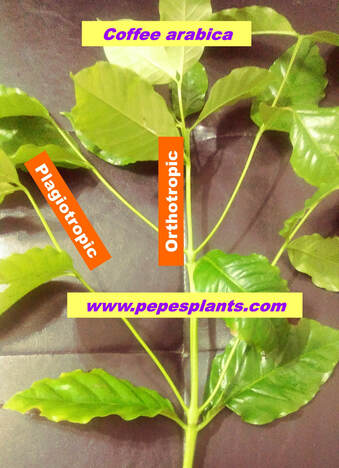
This image illustrates the two main type of branches that make up the structure of the coffee tree. The plagiotropic branches always grow in a lateral direction. These laterals produce the flowers and then the fruit. The Orthotropic branches grow vertically and is the main trunk of the coffee tree. The trunk very rarely produces fruit. When propagating plants use the orthotropic branches instead of the lateral branches. The plagiotropic branches will always grow sideways and the orthotropic straight up. As the orthotropic branch grows it shoots out lateral branches on either side that will have the ability to produce coffee cherries. To make a cutting use a pencil thick green orthotropic stem. More information coming soon.
Okay, three years have passed and you have your first amazing crop of coffee cherries.
Congratulations, now get to work! Harvest your beans or cherries by hand when they are a nice bright red color. Each cherry has one or two beans inside. Most of the time (about 90 - 95 percent) two beans are produced per fruit. Some people believe that single seeds/beans taken from cherries are actually much better tasting. They are called a peaberry or a caracol. These single cherries are rounder in shape and are claimed to roast more evenly than the typical coffee bean. How do I get seed? You can obtain seeds from online sources. Be sure to order fresh coffee seeds (also called green coffee beans) and plant immediately in deep pots. Place them in a shady area and keep them warm and moist. Fresh seeds germinate in a few weeks to a few months depending on how hot the weather is and how lucky you are. Many people fail at sprouting green coffee beans. They are usually not that fresh. A better option might be to find someone in your area that grows coffee and will give you some fresh cherries. That's the quickest way to get seeds started. The germination rate from fresh seeds taken right from the cherry will be much, more likely and quicker than ordering online seeds. In Florida most fresh seed will germinate in 6 - 8 weeks when planted in the summer. Not able to find good fresh seed? Well then get a plant and wait until it produces cherries. Call me in three years and I will come right over for a fresh cuppa Joe from your tree. LOL. :-) Jason "Pepe"
|
Nutrient deficiencies
|
|
* FDA Disclaimer
The products and statements made about specific plants or products on this web site have not been evaluated by the United States Food and Drug Administration (FDA) and are not intended to diagnose, treat, cure or prevent disease. All information provided on this web site or any information contained on or in any product label or packaging is for informational purposes only and is not intended as a substitute for advice from your physician or other health care professional. You should not use the information on this web site for diagnosis or treatment of any health problem. Always consult with a healthcare professional before starting any new vitamins, supplements, diet, or exercise program, before taking any medication, or if you have or suspect you might have a health problem.
Advertising Disclosure:
Pepesplants.com is a participant in the Amazon Services LLC Associates Program and also Googles affiliate advertising program. The programs provide a means for web sites to earn revenues from advertising and or sales.
Content Disclosure
Use all information on this site at your own risk.
The content here is based on the publishers personal experience in the green industries.
Although every reasonable effort has been made to ensure the accuracy of the information contained on this site, absolute accuracy cannot be guaranteed. This site, and all information and materials appearing on it, are presented to the user "as is" without warranty of any kind, either express or implied
The products and statements made about specific plants or products on this web site have not been evaluated by the United States Food and Drug Administration (FDA) and are not intended to diagnose, treat, cure or prevent disease. All information provided on this web site or any information contained on or in any product label or packaging is for informational purposes only and is not intended as a substitute for advice from your physician or other health care professional. You should not use the information on this web site for diagnosis or treatment of any health problem. Always consult with a healthcare professional before starting any new vitamins, supplements, diet, or exercise program, before taking any medication, or if you have or suspect you might have a health problem.
Advertising Disclosure:
Pepesplants.com is a participant in the Amazon Services LLC Associates Program and also Googles affiliate advertising program. The programs provide a means for web sites to earn revenues from advertising and or sales.
Content Disclosure
Use all information on this site at your own risk.
The content here is based on the publishers personal experience in the green industries.
Although every reasonable effort has been made to ensure the accuracy of the information contained on this site, absolute accuracy cannot be guaranteed. This site, and all information and materials appearing on it, are presented to the user "as is" without warranty of any kind, either express or implied
Site created and managed by Pepe's Fruit Trees. Copyright 2024 - All Right Reserved
Site created and managed by Pepe's Fruit Trees. Copyright 2024 - All Right Reserved



